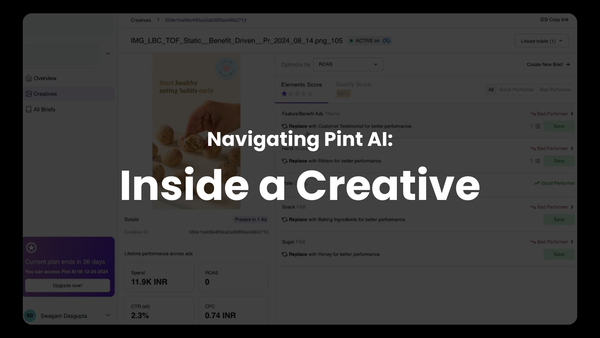Creative Analytics 102: Keep an Eye on Layout & Basic Design of Ad Creatives
The basic structure and layout of ad creatives are super important when you're looking at increasing their performance. An ad structured the right way can have more impact than you know. Here's how

Did you know that the layout and the basic design of ad creatives can have a huge impact on performance? The way an ad is structured and the visual arrangement of its components influence how effectively it communicates its message, captures attention, and drives engagement.
But just how does this happen? Let's dig in.
Why Layout and Design Matter
Let's begin with the basics; the visual hierarchy of your ad matters. This refers to the arrangement of elements in a way that directs the viewer’s attention in a specific order.
It ensures that the most important information is seen first and secondary information follows logically.
Effective visual hierarchy can guide the viewer’s eye through the ad, making the message clear and compelling.
Key Techniques:
- Size and Scale: Larger elements attract more attention. Headlines or key messages should be larger than secondary text to ensure they are noticed first.
- Contrast: Using contrasting colors or bold text can make important elements stand out. This helps in emphasizing CTAs or critical information.
- Position: Placing crucial elements in prominent positions, such as the top or center of the ad, can ensure they are seen quickly.
Example:
Apple’s ads often use a strong visual hierarchy, with large, bold headlines, high-quality imagery, and clear CTAs that guide the viewer’s attention seamlessly.
Balance and Spacing
Balance refers to the distribution of visual weight within the ad. A well-balanced ad feels stable and aesthetically pleasing, while an unbalanced ad can feel chaotic and confusing.
Proper spacing ensures that elements are not cluttered, making the ad easier to read and visually appealing.
Types of Balance:
- Symmetrical Balance: Elements are evenly distributed on either side of a central axis. This creates a formal and orderly look.
- Asymmetrical Balance: Different elements are balanced by visual weight rather than symmetry. This can create a more dynamic and interesting layout.
Importance of White Space:
White space, or negative space, is the empty space around elements in a design. It prevents clutter and helps to highlight important content. Adequate white space makes the ad look clean and professional, improving readability and focus.
Example:
Google’s search ads use significant white space, creating a clean and uncluttered appearance that highlights the search results and ads effectively.
Consistency and Alignment
Consistency in design elements such as colors, fonts, and imagery helps in building a cohesive brand identity. Consistent layouts across different ads reinforce brand recognition and trust.
Proper alignment, on the other hand, ensures that elements are visually connected and organized. Misaligned elements can look messy and unprofessional, reducing the overall effectiveness of the ad.
Example:
Coca-Cola’s ads consistently use their signature red color and distinct typography, ensuring brand consistency and immediate recognition.
Readability and Accessibility
The layout should ensure that the text is readable and accessible — this is super important! This includes choosing legible fonts, appropriate font sizes, and sufficient contrast between text and background.
Ads should also be designed with accessibility in mind, ensuring they are readable by people with visual impairments. This includes using high contrast, avoiding text over busy backgrounds, and considering color blindness.
Example:
Microsoft’s ads often include high contrast and clear, readable fonts, making them accessible to a broader audience.
Visual Appeal and Engagement
A visually appealing ad can capture attention and engage viewers more effectively. The use of attractive images, harmonious color schemes, and balanced layouts can create an aesthetically pleasing ad that draws viewers in.
Further, incorporating interactive elements such as animations, clickable buttons, or hover effects can enhance engagement. Interactive ads encourage viewers to interact with the content, increasing engagement time and effectiveness.
Example:
Interactive banner ads on websites often use animations and engaging visuals to capture attention and encourage interaction.
Best Practices for Effective Layout and Design
- Prioritize Key Elements:
Identify the most important elements of your ad and ensure they are prominent. Use size, contrast, and positioning to highlight these elements. - Use Grids:
Designing with grids helps maintain alignment and consistency. Grids can provide a structure that ensures a balanced and organized layout. - Incorporate Visual Hierarchy:
Arrange elements in a way that guides the viewer’s eye through the ad. Use size, contrast, and placement to create a clear visual hierarchy. - Maintain Consistency:
Use consistent design elements across all ads to build a cohesive brand identity. This includes colors, fonts, and imagery. - Leverage White Space:
Utilize white space to prevent clutter and improve readability. White space can help highlight important elements and create a clean design. - Focus on Readability:
Ensure that text is easy to read by choosing legible fonts, appropriate sizes, and high contrast. Avoid placing text over busy backgrounds. - Test and Optimize:
Conduct A/B testing to determine the most effective layout and design. Use analytics to track performance and make data-driven adjustments.
Conclusion
The layout and design of digital ads play a crucial role in their performance. Implementing best practices in layout and design will help create more effective and impactful digital ad campaigns.
By understanding and optimizing these elements, brands can enhance the overall effectiveness of their digital advertising efforts and achieve better results.





